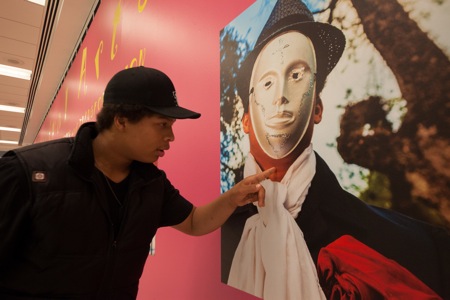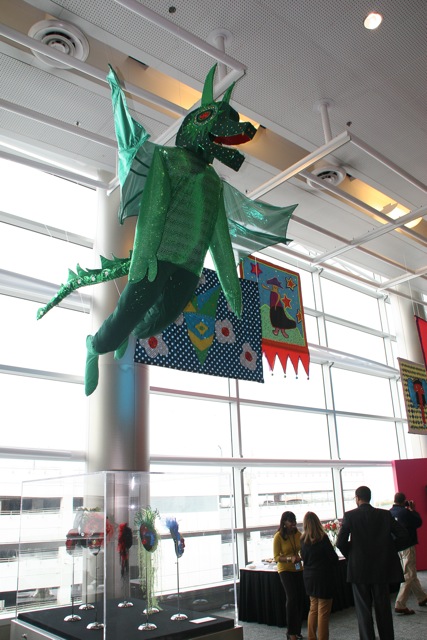
A “Carnival” of arts at MIA
Dealing with airports can often be a pain. But if you want to arrive early to our own MIA – or just make a trip of it – there is a very special treat awaiting on the fourth floor of the South Terminal, and it will make the whole airport hassle float away. The art show, “Carnival Arts Caribbean Carnival Party” is a unique, magical, wonderful exhibit (MIA has a lot of art, but this is an exhibit). It is filled with masks and mannequins, flying dragons, and video made from at-risk kids from Miami, all related to Caribbean carnival traditions.
Teen artist Bernie with his portrait by Alex Heria.
First off, we get to learn about the colorful, emotive celebrations and parades that take place before Easter every year across the Caribbean, from Cuba to Trinidad, Jamaica to Haiti. The imagery and costumes and masks are a hybrid of African and European Catholic cultures, expressing fears and hopes, questioning the nature of life and death. Here at MIA, there is an added element, in that the teens-turned-artists get to make delightful but intense works that, as the wall notes explain, lets them through vehicles such as masks “hide identities but reveal how they really feel.” They are residents in Miami Bridge, a youth crisis shelter for troubled, abused and runaway teens. The Carnival Arts has been an ongoing project, organized by Celeste Fraser Delgado and documented by Damian Rojo, where the kids create art, dance, play percussion, all in order to express their inner feelings.
“A Flying Dragon.” Photo by Carlos Ochoa
So, to start, the first display is a number of masks, plaster casts of the teens own faces, colored in vibrant blues, sprinkled with red and gold glitter, based on the “mischievous devils” who appear in Dominican Republic carnivals.
Then there are somewhat darker sculptures, skeletal-like creatures that have their origins in Rio de Janeiro’s carnival traditions. These “Brazilian Zombies” are cloaked in black, hearkening back to the famous samba-dance schools that have helped make the Rio carnival parade the biggest in the world.
There are displays with masks and mannequins based on carnival cultures of many other countries – warrior “gods” from Cuba, dressed in regal purple and gold, Mexican Day of the Dead imagery. “The Midnight Robber,” sculptures made from foam boards and covered in glitter, comes out of the Trinidadian roots of a midnight trickster.
As becomes evident, the fascination with death, and how it brings this world to vivid life, is a theme in carnivals – and with these kids. Whether living through the relentlessly brutal life of a slave on a plantation two centuries ago, or as an abandoned child in this decade, the time to break free, celebrate and express oneself in a “carnival” has become an extraordinary tradition on many levels.
The only problem with this exhibit is that far too few people likely saw it. So many of Miami’s histories are reflected here, including the European one – there is a display based on the Venetian carnival, with masks made from egg cartons, from the city that is thought to be the originator of carnival.
On Thursday, you can catch the closing party, from 4-6 p.m.
“Carnival Arts Caribbean Carnival Party,” with Haitian carnival dance and drumming workshop featuring master drummer Catelus “Ton Ton” Laguerre; Thursday, April 11 from 4-6 p.m. South Terminal Gallery, fourth floor mezzanine (enter at the TAM/Alitalia door), Miami International Airport; carnivalarts.us.
Recent Content
-
Artsarticle ·
-
Artsarticle ·
-
Artsarticle ·


